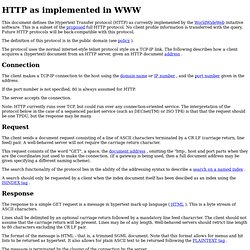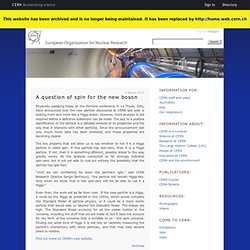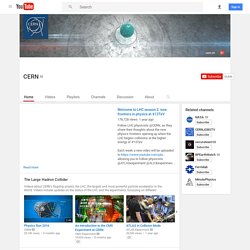

Read Me. /LineMode. NewsServer. Overview. Bibliography. Installing WorldWideWeb on the NeXT. The HTTP Protocol As Implemented In W3. This document defines the Hypertext Transfer protocol (HTTP) as currently implemented by the WorldWideWeb initaitive software.

This is a subset of the proposed full HTTP protocol. No client profile information is transferred with the query. Future HTTP protocols will be back-compatible with this protocol. The definition of this protocol is in the public domain (see policy ). The protocol uses the normal internet-style telnet protocol style on a TCP-IP link. Connection The client makes a TCP-IP connection to the host using the domain name or IP number , and the port number given in the address. If the port number is not specified, 80 is always assumed for HTTP. The server accepts the connection. Note: HTTP currently runs over TCP, but could run over any connection-oriented service. Request The client sends a document request consisting of a line of ASCII characters terminated by a CR LF (carriage return, line feed) pair.
Response Disconnection Requests are idempotent . HyperText Mark-up Language. Hypertext Terms. Hypertext HTML formatting example. Future plans for HTML. The HTML language has been in use in the field since 1990, and several suggestions have been made for improvements.

See working notes . A new DTD will be the result. Bad HTML Much of the HTML actually around has been generated by the NeXTStep editor, which has in fact generated bad HTML. This should not confuse the specification. A perl script was written by Dan Connolly to clean up bad HTML. Also, see Dan's HTML spec (draft) which contains a sort of test suite. New features Please mail me mentioning this list if you think of features I have missed out. Header A wrapper element for all the document-wide information such as title, document-wide links, etc. Disadvantage: If mandatory, the size of the minimum document is increased. A "Body" tag might be useful in the same light, for the rest. Link A document-wide link, as distinct from a localized anchor.
Guide. Distribution. InstallNotSU. The history of CERN. World's First Website. World's First Web Address. The WorldWideWeb (W3) is a wide-area hypermedia information retrieval initiative aiming to give universal access to a large universe of documents. Everything there is online about W3 is linked directly or indirectly to this document, including an executive summary of the project, Mailing lists , Policy , November's W3 news , Frequently Asked Questions . What's out there?
Pointers to the world's online information, subjects , W3 servers, etc. Help on the browser you are using Software Products A list of W3 project components and their current state. Technical Details of protocols, formats, program internals etc Bibliography Paper documentation on W3 and references. People. The document that officially put the World Wide Web into the public domain on 30 April 1993. - CERN Document Server. Accelerating science. Visit CERN - Microcosm. The European Organization for Nuclear Research. 6 March 2013 A question of spin for the new boson Physicists speaking today at the Moriond conference in La Thuile, Italy, have announced that the new particle discovered at CERN last year is looking more and more like a Higgs boson.

However, more analysis is still required before a definitive statement can be made. The key to a positive identification of the particle is a detailed analysis of its properties and the way that it interacts with other particles. Since the announcement last July, much more data has been analysed, and these properties are becoming clearer. The key property that will allow us to say whether or not it is a Higgs particle is called spin. "Until we can confidently tie down the particle's spin," said CERN Research Director Sergio Bertolucci, "the particle will remain Higgs-like. Even then, the work will be far from over.
Find out more on CERN's new website. Archives. CERN. Follow LHC physicists @CERN, as they share their thoughts about the new physics frontiers opening up when the LHC begins collisions at the higher energy of #13TeV.

Each week a new video will be uploaded to allowing you to follow physicists @ATLASexperiment @ALICEexperiment @CMSexperiment or @LHCbExperiment. Read more about these new frontiers in physics: -Producer-CERN Video Productions -Content-Corinne PralavorioPaola CatapanoCian O'LuanaighKatarina AnthonyDan Noyes.